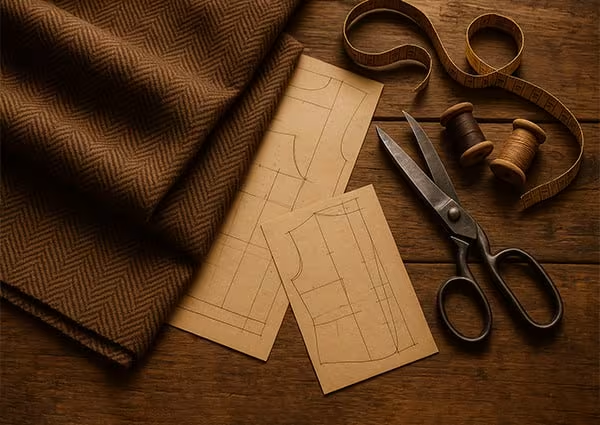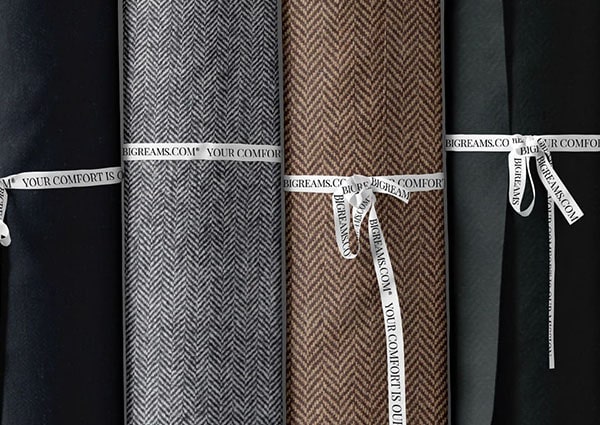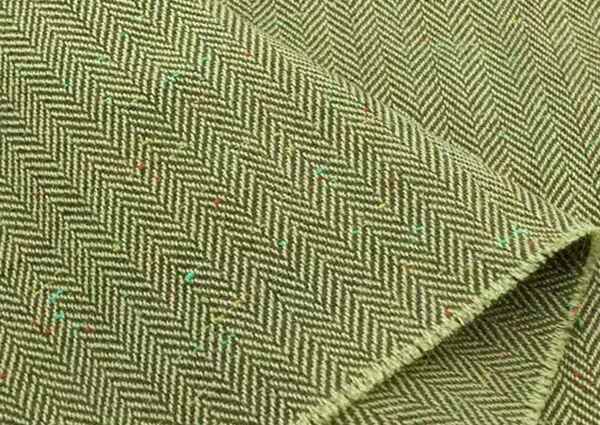Herringbone Wool Tweed:The History it’s Heritage

Introduction to Herringbone Wool Tweed
Very few textiles tell a story so rich and long-lasting as Herringbone Wool Tweed. It is easily identified by its distinctive V-shape weave, that is that resembles a herringfish’s skeleton, this material has been through a fascinating voyage. From the secluded weaving communities in Ireland and Scotland in which it was originally designed to protect from wind and damp and wind, through the elegant coats worn by British elites and to the haute couture runways in Paris, London, and New York, herringbone tweed has transcended geography, time as well as fashion trends.
Herringbone tweed today is much more than an item of clothing. It’s an emblem of high-end craftsmanship, tradition and timeless fashion. What made a tough fabric designed for survival during harsh conditions become among the top recognizable designs in fashion? Let’s review of the background as well as the heritage and contemporary revival of the herringbone Tweed.
Origins in Ireland & Scotland
The Birth of Tweed
The origins of tweedwhich includes the herringbone variant are located in the fog-shrouded scenery in Ireland as well as Scotland. The 18th and 19th century, villages were dependent on the hand-woven wool fabric to withstand the harsh conditions. The rough, dense appearance of tweed lent warmth while the dense weave kept out water.
Tweed wasn’t just a fabric but it was a way to protect yourself from weather elements. Families spun and dyed their wool with natural substances such as moss, lichen and heather. They would create earthy hues that merged with the landscape of the moors and rolling hills.
The Herringbone Tweed Pattern Emerges
Herringbone’s pattern itselfwhich is a staggered zig-zagcreated as means of creating more strength and flexibility in fabric. With the use of diagonal weaves in alternating patterns, craftsmen ensured that the cloth was resistant to being stretched and would wear more evenly with time. It resembled the herring’s backbone and hence the term “herringbone.”
The clever design created a fabric that was not only easier to use, but added the unique texture that caught attention.
Adoption by British Aristocracy
From Peasantry to Prestige
In the late 19th century, tweed started to attract the attention of British Aristocracy especially for country sports like fishing, hunting, as well as riding. Landowners who were wealthy, influenced by their rural heritage, began making customized tweed outfits for their properties.
The Duke of Norfolk and, later, his successor, the Prince of Wales (who changed his name to Edward VIII) played key role in promoting Tweed as the sign of luxury and lifestyle. It was a humble farmer’s cloth came to be an emblem of prestige and exclusiveness.
Why Aristocrats Loved Herringbone Tweed
- The practicality Warm and thick ideal for long hours out in the open.
- Camouflage earthy hues blended effortlessly into natural landscapes.
- Long-term durability: Has stood up to rough terrain conditions, extreme weather, and vigorous life styles.
Herringbone tweed with its sophisticated zig-zag design provided an superior and elegant take over plain weaves. It was quickly the go-to most popular choice for waistcoats, jackets and pants for gentlemen who participated in sports events.
From Countryside to High Fashion
Early 20th Century Transition
In the twentieth century, the tweedwas once restricted to farms and pursuits in the countryside -was being incorporated into modern wardrobes. Tailors who worked in London were aware of the advantages of herringbone tweed to make suiting up in city attire particularly as males were looking for clothes that mated fashion and practicality.
Hollywood & The Silver Screen
In the 20th century’s mid-century, Hollywood celebrities and other cultural icons brought herringbone tweed to international popularity. The actors like Cary Grant, Gregory Peck and, later on Sean Connery as James Bond were seen wearing tweed jackets which exuded elegance and style.
The appearance of tweed changed once a rural fabric to an international style statement. Females too took to tweed. Designers like Coco Chanel using herringbone tweed for elegant coats and suits.
The Fashion Runway Embrace
In the 60s and 70s the most renowned designers began to experiment using tweed for new styles. It was no longer only reserved for hunting clothes herringbone tweed gained popularity and appeared in
- Jackets with tailored styles for females and males
- A-line skirts, dresses, and skirts
- Urban-chic coats and overcoats
In the years from Savile Row in London From Savile Row in London Paris fashion houses herringbone tweed established its status as an fashion icon.
Modern Uses & Sustainability
Tweed Today
The 21st century is a time when herringbone tweed is continuing to develop. Herringbone tweed isn’t just limited to formal suits—it also shows up in fashion pieces, accessories, upholstery, and even sneakers. Its mix of elegance and ruggedness makes it work with almost any style..
Why It’s Still Relevant
- Timelessness: The design remains fashionable for more than two decades.
- Versatility – Suitable for countryside weekends, business meetings, or fashion editorials.
- Sustainability Wool is renewable, biodegradable and resilient material.
In a time when consumers are becoming increasingly aware about the environmental impacts of fashion, herringbone wool tweed has returned as a sustainable textile option. In contrast to synthetic textiles which are not biodegradable can withstand wear for years and needs fewer washes.
Modern Designers Keeping Tweed Alive
Brands like Harris Tweed, Ralph Lauren as well as Alexander McQueen regularly use herringbone tweed to create the collections of their seasonal. In large coats, striking bags, or even blazers Tweed has remained an iconic fashion staple across the generations.
Styling Herringbone Tweed
If you’re looking to incorporate heritage elements into their outfits These are fashionable styling suggestions:
Men’s style: Pair a herringbone coat with dark jeans and Chelsea boots to create a chic-casual style.
Women’s Fashion: A herringbone-patterned coat that is with a turtleneck over pants creates an elegant and timeless look.
Accessories The Herringbone Tweed Caps accessories, scarfs, and bags provide subtle elegance.
The trick is to let the tweed’s character and texture be the main focus and keep your overall outfit minimalist and contemporary.
Herringbone Tweed & Interior Design
Beyond fashion, herringbone Tweed is now a part of the interior design. The cushions, upholstered chairs or even walls covered with tweed add a touch of warmth and comfort in homes. The timeless zig-zag weave gives warmth and dimension but doesn’t overwhelm a room.
The transition to interiors increased the longevity of tweed, making sure it is present in the living and wardrobe spaces.
Bring the Heritage Home
If you’re looking to work with a cloth that has more than a century of elegance, workmanship, quality, and history, then our Brown Herringbone Wool Tweed is a fantastic selection. It is woven with the same commitment to excellence that has made tweed so famous and is able to offer:
- Durability that lasts for years of wear
- Design from the past that is modern and appealing
- Sustainable and eco-friendly, using wool fibers made from natural wool
You may be a tailor, designer, or one who appreciates timeless fabrics, herringbone tweed can connect the wearer to an era of rich tradition and is still relevant to the present.
Conclusion
Herringbone tweed’s story can be a testimony to the way practicality and tradition will evolve into timeless beauty. This was born in the harsh terrains of Ireland and Scotland, the aristocratic class adopted it for their leisure, fashion designers reimagined it for the style capitals of today, and people now praise it for its sustainable nature. It truly is an all-purpose fabric that is suitable for everyone.
If you work in tweed that has herringbone, you’re not simply choosing a material, but you’re also selecting the tradition, a history, as well as a heritage of excellence that has endured throughout the ages.
Ready to start your next masterpiece?
Shop our Herringbone Wool Tweed Fabric here and bring timeless style to life.
Follow us on our Instagram: @thebigreams




